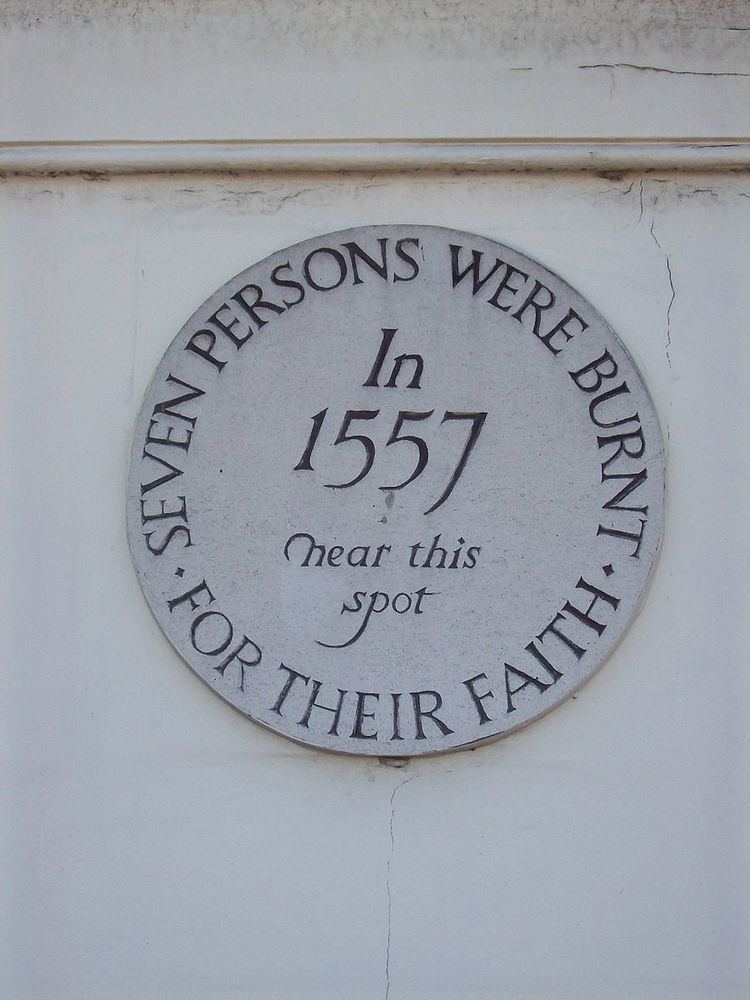 | ||
Protestants were executed under heresy laws during persecutions against Protestant religious reformers for their religious denomination during the reigns of Henry VIII (1509–1547) and Mary I of England (1553–1558). Radical Protestants were also executed during the reigns of Edward VI (1547–1553), Elizabeth I (1558–1603) and James I (1603–1625). The excesses of this period were recorded in Foxe's Book of Martyrs.
Contents
- Posthumous proceedings
- Protestants executed under Mary I
- Also mentioned by Foxe
- Radical Protestants executed under Elizabeth I
- Historical context
- Troubles for Protestants
- English Inquisition and the judicial process
- Cathedrals in operation
- John Rogerss execution
- Observations
- Legacy
- References
Protestants in England and Wales were executed under legislation that punished anyone judged guilty of heresy against Catholicism. Although the standard penalty for those convicted of treason in England at the time was execution by being hanged, drawn and quartered, this legislation adopted the punishment of burning the condemned. At least 300 people were recognised as burned over the five years of Mary I's reign by contemporary sources.
Catholics were also executed (under charge of treason) during the reign of Elizabeth I. See List of Catholic martyrs of the English Reformation.
Posthumous proceedings
Protestants executed under Mary I
Note: Mary I died on 17 November 1558.
Also mentioned by Foxe
Posthumous proceedings
Radical Protestants executed under Elizabeth I
John Penry (1563 - 1593), the Welsh Puritan author (who was allied with the London Separatist followers of Henry Barrow), was arrested on 22 March 1592/3. Indicted under the Act of Uniformity (1 Eliz. cap. 2), he was executed by hanging at S. Thomas a Watering on 29 May 1593. The first signature on John Penry's death warrant was that of Elizabeth I's Archbishop of Canterbury, John Whitgift.
Historical context
The English Reformation had put a stop to Catholic ecclesiastical governance in England, asserted royal supremacy over the English Church and dissolved some church institutions, such as monasteries and chantries.
An important year in the English Reformation was 1547, when Protestantism became a new force under the child-king Edward VI, England's first Protestant ruler. Edward died at age 15 in 1553. Lady Jane Grey tried to succeed as Queen for nine days before Edward's Catholic half-sister Mary deposed her and assumed the crown, as was stipulated by Henry VIII in his Third Succession Act but revoked by Edward VI.
The relationship between the English church and Rome was restored under Mary in 1553. She went on to reign for five years (1553–1558) until her death. Protestants opposed Mary's actions. Many people were exiled, and hundreds of dissenters were burned at the stake, earning her the nickname "Bloody Mary". The number of people executed for their faith during the persecutions is thought to be at least 287.
Troubles for Protestants
After the accession of Queen Mary I to the English throne in 1553, and her repeal of all religious legislation passed under Edward VI, Protestants faced a choice: exile, reconciliation/conversion, or punishment. Mary had some 284 Protestants burned at the stake (including 56 women). Thirty others died in prison. While the so-called "Marian Persecutions" began with four clergymen, relics of Edwardian England’s Protestantism, Foxe’s Book of Martyrs offers an account of the executions, which branched well beyond the anticipated targets – high-level clergy. Tradesmen were also burned, as well as married men and women, sometimes in unison, "youths" and at least one couple was burned alive with their daughter.
English Inquisition and the judicial process
However bloody the end, the trials of Protestant heretics were judicial affairs, presided by Bishops (most notably Bishop Bonner) adhering to a strict legal protocol under the privy council, with Parliament's blessing. Mary had difficulty forming an efficient Privy Council, which eventually numbered over 40 and never worked as a source of political advice, though it effectively pursued police work and enforcement of religious uniformity. During the session that restored the realm to papal obedience parliament reinstated the heresy laws. From 20 January 1555, England could legally punish those judged guilty of heresy against the Catholic faith.
Thus it became a matter of establishing the guilt or innocence of an accused heretic in open court – a process which the lay authorities employed to reclaim "straying sheep" and to set a precedent for authentic Catholic teaching. If found guilty, the accused were first excommunicated, then handed over to the secular authorities for execution. The official records of the trials are limited to formal accusations, sentences, and so forth; the documents to which historians look for context and detail are those written by the accused or their supporters.
Cathedrals in operation
England
Wales
John Rogers's execution
Before Mary's ascent to the throne, John Foxe, one of the few clerics of his day who was against the burning of even obstinate heretics, had approached John Rogers to intervene on behalf of Joan of Kent, a female Anabaptist who was sentenced to burning in 1550. Rogers, a Protestant preacher and royal chaplain, refused to help, as he supported the burning of heretics. Rogers claimed that the method of execution was "sufficiently mild" for a crime as grave as heresy. Later, after Mary I came to power and converted England to Catholicism, John Rogers spoke quite vehemently against the new order and was burnt as a heretic.
Observations
The figure of 300 victims of the Marian Persecutions was given by Foxe and later by Thomas Brice in his poem, "The Regester".
Legacy
Throughout the course of the persecutions, Foxe lists 312 individuals who were burnt or hanged for their faith, or died or sickened in prison. Lists of these names are available here and here. Three of these people are commemorated with a gothic memorial in Oxford, England but there are many other memorials across England. They are known locally as the "Marian Martyrs".
